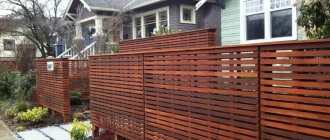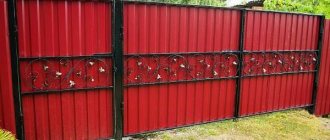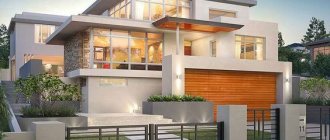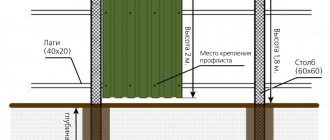Fence
The most famous type of wooden fence is a picket fence. The word "fence" comes from the German Stake, which means stake, pole, post. When creating such a fence, boards (pickets) are attached to horizontal slats.
They are most often placed vertically and at some distance from each other. The top of the boards can be straight, beveled, pointed, rounded, etc. The pickets are painted or covered with varnish or stain.
Support posts for a picket fence are made not only from wood. Often stone, metal or brick are used to create them. This design looks more attractive and is more durable.
What boards are used to install fencing?
When choosing a material, pay attention to the thickness of the boards. The most suitable is 18-24 mm. Thicker ones usually cost more, thin ones break quickly.
If the owner of the property has taste, a wooden fence can look expensive and truly impressive.
Also used:
- An unedged board is a rough product, has uneven edges and parts of bark. Suitable for temporary structures where aesthetic appearance is not important. The material is inexpensive and is sold almost everywhere. It can be used for buildings in country and rustic style;
- Croaker is one of the varieties of unedged boards. Has one convex and one flat side;
- Edged board is the most popular option, suitable for all types of fences;
- Planed board - after processing the edges, it additionally passes through a surface planer or a jointer;
- Lining - strips of small thickness, cut using a machine, having protrusions and recesses at the ends for convenient connection with supports and each other. A fence made of clapboard is a continuous, transparent fence that needs to be periodically treated with protective compounds so that it lasts as long as possible;
- Curly decorative strips - each of them has an unusual shape, is decorated with carvings, the ends are also made figured. The finished structure usually looks like a picket fence;
- Artificially aged boards - created from unedged boards through special processing;
- Terrace or deck boards are made from wood flour, modifying substances, and polymers. The finished fence is very durable, looks beautiful and original. The parts themselves are made smooth or corrugated;
- Brushed board - its top layer is “lifted” with a special brush. The structure has a unique texture - growth rings are visible on the surface.
A beautiful edged board fence is the most popular fencing structure. It is made solid, smooth or has holes that allow sunlight to pass through. The product is an order of magnitude more expensive than a fence made of slabs or unedged planks.
Fencing the estate is one of the most necessary elements in a garden plot, regardless of its size.
A fence made of boards with horizontal laying is called “American”. It is installed on concrete pillars and protected from rain by a canopy. The finished structure looks very reliable, impregnable, it belongs to the elite version. The boards for it are dried in the factory - only high-quality wood is selected. This type of fence is made from dry facing boards, mounted in special overlapping sections and only horizontally. The design does not allow viewing the area from the outside, which should be taken into account if the area is small and narrow. The average height of the structure is 1.6-2.2 meters, but some owners of luxury mansions build fences even three meters high.
Wood as a raw material is more expensive than profiled sheets, but cheaper than brick or forged metal.
Wattle
Wattle fence is the oldest and most cost-effective type of fencing. To create it, flexible branches of various trees or shrubs are used.
In the middle zone, wattle is most often made from willow or hazel twigs. They can be placed both horizontally and vertically, creating various wicker patterns.
As a rule, wattle fence is used for zoning a playground, recreation area or flower garden. However, sometimes a wicker fence is used to fence an entire area. Such a fence fits especially organically into a site decorated in ethnic or country style.
Wattle is also used in the garden - to fence high beds.
Palisade
A palisade is approximately the same ancient hedge as a wattle fence, but more reliable. It is used to fence not individual zones, but the entire area.
A palisade is made from vertically located logs or stakes (most often pointed at the top), tightly located next to each other. Such a fence provides the best protection from prying eyes and uninvited guests.
If you approach the design of the fence with creativity (paint it or add decorative details), then an ordinary “boring” picket fence can be turned into a creative and memorable fence.
How to extend the life of a decorative fence
Wood is susceptible to rotting, it absorbs moisture, resulting in favorable conditions for the development of fungus and mold. Without special treatment, wooden products are easily flammable and burn in a matter of minutes in an open fire. All these factors contribute to reducing the shelf life of the decor. In order to prolong it, you need to treat decorative fences annually with a penetrating antiseptic solution. Those elements that will be in the ground are soaked for one or two days in copper sulfate.
lattice fence
If a solid fence seems too heavy to you, then pay attention to a lighter structure - a lattice.
When creating such a fence, the slats are placed at an angle of 45° or 90° to each other, leaving large gaps between them. Thanks to this, the fence seems airy and openwork.
In order for the fence to serve not only a decorative, but also a utilitarian function, two types of fencing are sometimes combined: the lower part is made solid, and an openwork lattice part is placed at the top.
There is another way to make the lattice opaque - plant climbing plants along the fence.
- 9 best fast-growing climbing flowers for fences, arches and trellises in the country (27 photos)
9 climbing plants that will transform your garden beyond recognition.
Functional purpose
A simple wooden fence is the most functional decoration in landscape design. Small and elegant, it helps create an atmosphere of safety and security. Essentially, this is a psychological barrier that allows you to form a barrier and separate one space from another. Such decor can prevent an accident by blocking the path of a small child.
Wood is a natural, environmentally friendly material. It has a texture that fits very well into any stylistic concept. Wooden dacha fences look very decorative. They help give the landscape a finished appearance.
The described decor is made from available materials. In fact, you can make a similar fence yourself if you have certain construction skills. But it’s much easier to buy ready-made products and simply install them at your dacha. They are very affordable and manufacturers offer a wide range. Everyone will be able to choose something interesting for themselves. If desired, a decorative wooden fence can be painted in any color and change the mood of the landscape decor each time.
Factory modules ready for installation Source volpalisad.ru
"Ranch"
Not as common as other types of fencing, but still used to protect a ranch area. This is the name for a fence that was originally used as a fence for cattle pens.
It is made from horizontal boards placed on pillars. Sometimes they are supplemented with vertical or diagonal slats.
As you can see, there are many interesting options for a wooden fence - there is plenty to choose from. If you make a fence with your own hands, then do not forget to take into account the standards for installing fences between areas so that no problems arise later.
- What kind of fence to put between plots so as not to sue the neighbors later?
Have you decided to fence yourself off from your neighbors, but don’t know what kind of fence should be between the plots? We'll tell you!
Unedged board: definition, types
Unedged boards are called boards with unsawed, raw or partially processed edges. They cost much less than others, but are also reliable, durable, and suitable for use in outdoor conditions and harsh climates. Such materials are well processed, and the presence of knots and twists is regarded here as decoration.
The choice of this material is supported by its environmental friendliness.
The main types of unedged boards are fence and carpentry boards. For the first type, multiple but not falling out knots, changes in the direction of the fibers in some places, and minor damage to the material are acceptable. The second is higher quality raw materials, which have the minimum of defects and flaws. Lining is made from it, and the finished fence looks much more attractive than one built from fence boards.
There are special compounds to treat and protect a wooden fence from fungus or wood bugs.
For the production of unedged materials, the second or third cuts of a tree trunk are used - low-grade raw materials. The thickness of such planks is 25-50 mm, width is 100-200 mm. or a little more. The main raw materials are pine and spruce (larch is not a cheap material). When purchasing any type of unedged board for building a fence, it is recommended to choose one with fewer knots - such parts are more likely to maintain the correct geometry for a long time, avoiding deformation and cracking. When processing yourself, it is unacceptable to use excessively wet, under-dried boards - they will warp during use. Curved parts are also not suitable for a good fence.
You can cover the structure with varnish, drying oil or special paint enriched with protective substances.
A fence made from unedged boards is suitable for mixed landscapes, as well as those that are as close to nature as possible. It does not disturb the overall design of the site, but most often climbing ornamental plants are planted along such a structure.
Wood is a natural and eco-friendly material that does not pollute the environment.











